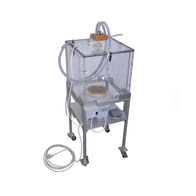Automatic Insect collector / Aspirator With Counter
In mosquito mass rearing and insect research facilities, the transfer of (defined numbers of) insects between rearing and experimental cages is routine.
Insect Aspirator / Mosquito Aspirator

IR-735 Insect Collector with Counter, an automatic insect aspirator to carefully collect and transfer a known number of flying insects from one cage to another. As a large-scale "pooter", the IR-735 aspirator uses a portable vacuum device to suck flying insects in with a nozzle head, counting them before entering the target insect cage. The inner chamber size (35 cm x 35 cm x 35 cm) of the VSI IR-735 Insect Aspirator is suitable for standard rearing cages ('target cages') up to 33 cm side length. Insects are captured in the source cage (or in vivo) via a variable length vacuum tube ("pick-up straw"); the associated fan to generate the suction force is screened and positioned under the target cage. Insect collection is started/stopped via a foot switch for easy, hands-free operation, or the fan can be set to continuous operation. As insects (mosquitos) enter the target cage, they are counted by a photoelectric sensor and the number collected is displayed. The unit requires 220 V; 110 V version on request. Please see the IR-735 specifications (pdf) below or contact us for details.
IR-735 - features
- Rapid transfer of a defined number of insects to a target cage
- Photoelectric counter
- Hands-free operation, with a foot switch
- Fits standard mesh cages used in mosquito rearing
Options:
- Target cages sizes of choice, custom


The acrylic housing of the Insect Aspirator is made from PMMA, which can optionally have a 70% post-consumer recycled content. Contact us if a more sustainably produced acrylic would meet your insect transfer needs.
Collection of Flying Insects - Methods
- Flying insects can be collected using a variety of methods, largely depending on the collection site, species and scope. Some common techniques are: ... Continue reading
-
- Sweep netting or other nets: This method involves using a large net, usually of fine mesh, to sweep through vegetation or other habitats where flying insects may be present. The net is swung through the air to catch insects in flight or to collect them from foliage. Other techniques use installed nets with colelctions flasks on top. Partially thes nets have different colours for effective collection.
- Light traps: Light traps use ultraviolet light to attract and capture nocturnal flying insects such as moths and beetles. The trap consists of a light source and a receptacle that can be filled with water or other liquid to preserve the insects.
- Sticky traps: Sticky traps are adhesive surfaces placed in areas where flying insects are likely to land or fly through. The traps can be made of various materials, such as paper or plastic, and can be coated with a non-toxic adhesive. This methodology is not suitable if insect have to be captured alive.
- Pheromone and similar chemical traps: Pheromone traps use sex pheromones or other attractants such as CO2 to lure certain species of flying insects into a trap. The traps typically consist of a lure or bait placed in a container.
- Vacuum sampling: This insect aspirator method uses a portable vacuum device to suck flying insects from vegetation or other habitats. The insects are collected in a container or bag attached to the vacuum. The VSI insect aspirator IR-735 follows this vacuum sampling principle to transfer insects carefully and in known numbers between insect rearing cages.
- Knocking or shaking: Moving branches or leaves can dislodge flying insects and cause them to fall onto a collection sheet or into a container placed underneath.
- Manual collection: At lowered temperatures, inmobilised insects can be transferred manually from the bottom of collection or release cages.
The choice of collection method will depend on the specific objectives of the study, the habitat and insect species of interest and the resources available. It is important to choose a method that is appropriate for the target insects and minimises damage to the collected specimens.
| References | Insect Aspirators | OPEN |
|
||
The Mosquito Aspirator is often used in mosquito mass rearing facilities where large amounts of larvae are reared in Mosquito Tray and Rack Mass Rearing Systems.
To measure the CO2 and O2 exchange and metabolism of insects, consider the Low Range Insect Respirometry Package. The insect aspirator IR-735 can be used to transfer a defined number of insect into the measuring tubes.











